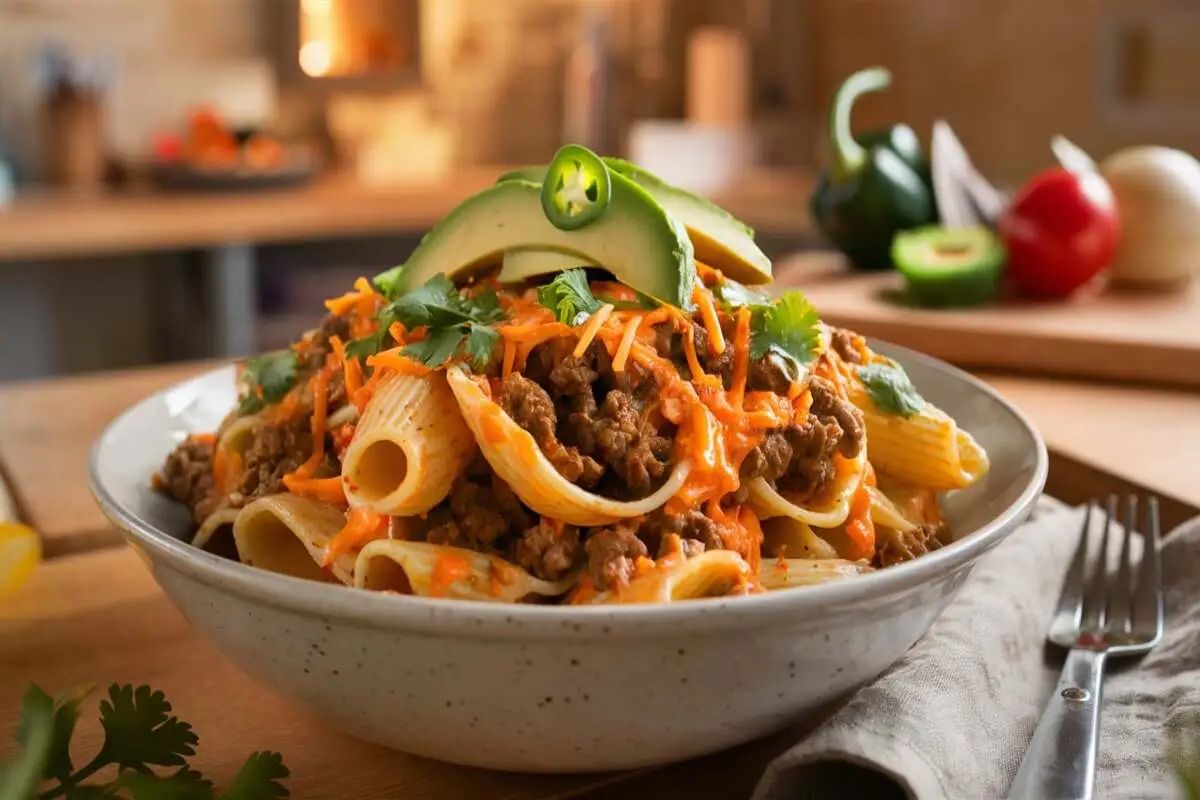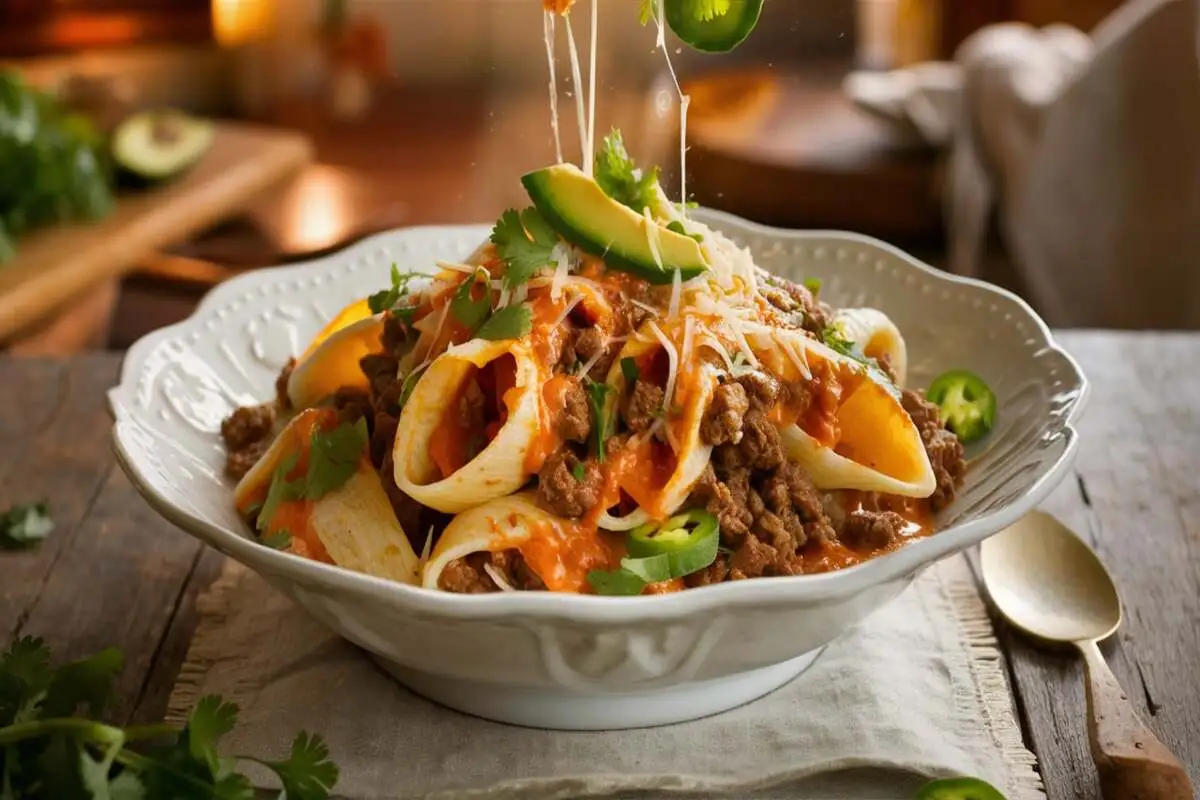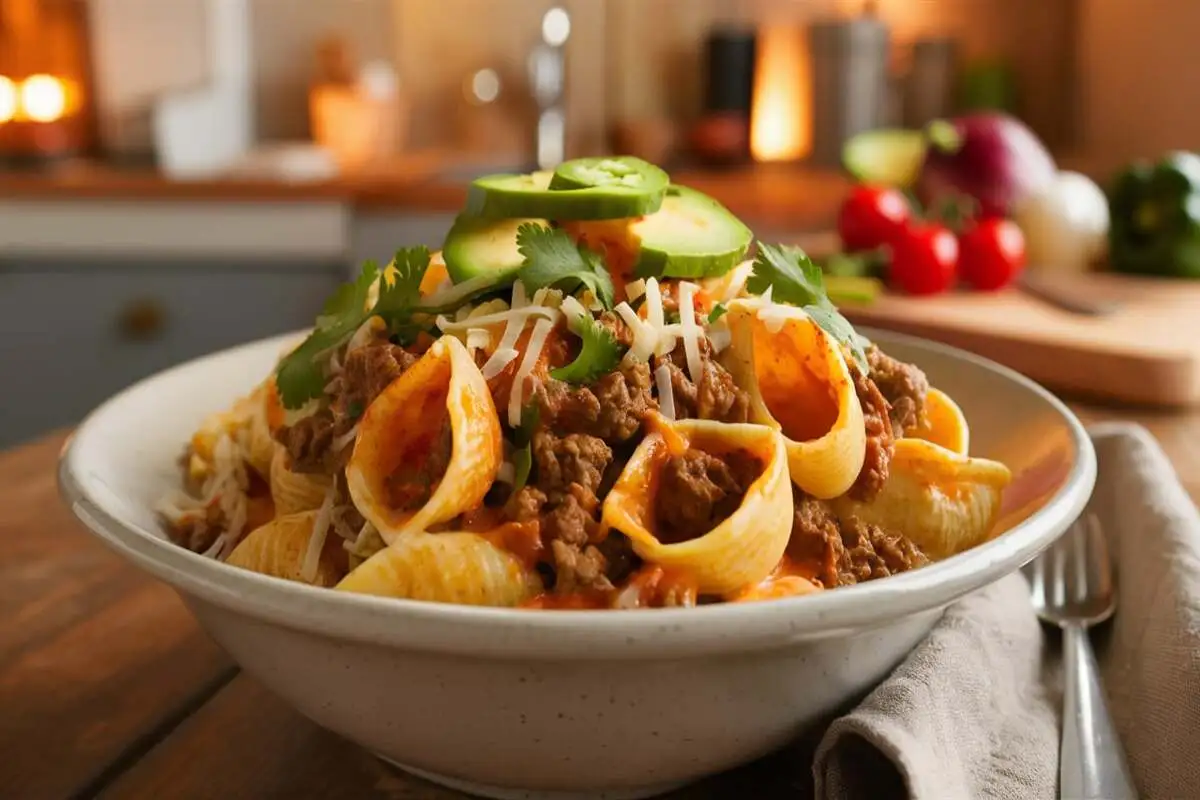When it comes to comfort food, nothing beats a dish that combines the best of two worlds. Enter the Taco Pasta Recipe—a mouthwatering fusion of spicy Mexican flavors and hearty Italian pasta. This dish is perfect for those busy weeknights when you crave something quick, easy, and delicious. In this article, we’ll dive deep into what makes Taco Pasta so irresistible, guide you through the step-by-step process of making it, and offer variations to suit every taste. Let’s get cooking!
What is Taco Pasta?
Taco Pasta is a delightful combination of classic Mexican taco flavors and Italian pasta. Imagine all the zesty spices of a taco—taco seasoning, salsa, and ground beef—blended with cheesy, creamy pasta. This one-pot dish is not only easy to make but also versatile, allowing you to customize it according to your preferences.
The concept of fusing different cuisines isn’t new, but Taco Pasta is a particularly successful example because it balances the richness of pasta with the vibrant flavors of tacos. This combination offers the heartiness of a pasta dish with the excitement of a taco night, making it a family favorite that both adults and kids love.
If you’re wondering how to make your own taco seasoning, check out this helpful Homemade Taco Seasoning Guide. This recipe gives you complete control over the spice levels, ensuring your Taco Pasta is just the way you like it.
The beauty of Taco Pasta is its flexibility. Whether you prefer it mild or spicy, loaded with veggies or meat-heavy, you can easily adapt the recipe to suit your tastes. Plus, it’s an excellent dish for using up leftovers—extra veggies, beans, or even a half-used jar of salsa can be thrown into the mix.
Key Ingredients in Taco Pasta Recipe
To create the perfect Taco Pasta, you’ll need a few essential ingredients:
-
Ground Beef or Turkey: The base protein that adds richness and depth to the dish. For a leaner option, choose ground turkey. The meat is seasoned with taco spices, providing the foundational flavor of the dish. Some people prefer to mix in ground pork or sausage for an extra layer of flavor.
-
Pasta Shells: Large or medium-sized shells work best as they capture the sauce and meat in every bite. However, feel free to experiment with different pasta shapes. For example, rotini or penne also work well because their ridges hold onto the sauce effectively.
-
Taco Seasoning: You can use store-bought seasoning or make your own Homemade Taco Seasoning. Homemade seasoning allows you to control the sodium content and avoid preservatives. You can also tweak the spice level by adjusting the amount of chili powder or adding a pinch of cayenne pepper.
-
Salsa or Diced Tomatoes: These add moisture and a tangy kick to the sauce. Salsa is especially useful because it adds depth of flavor, incorporating onions, garlic, and spices in one easy step. If you prefer a smoother sauce, opt for pureed tomatoes or a can of tomato sauce.
-
Cheese: Cheddar, mozzarella, or a blend of cheeses for that creamy, gooey finish. A combination of cheeses can provide a balance of flavors and textures—sharp cheddar for its tang, mozzarella for its meltability, and maybe a bit of Monterey Jack for its mild creaminess.
-
Optional Ingredients: Onions, garlic, bell peppers, beans (black or pinto), corn, sour cream, or cream cheese. These ingredients can enhance the dish’s nutritional value and flavor complexity. For a more robust dish, you can add beans or corn. If you prefer a creamier texture, stir in a dollop of sour cream or cream cheese before serving.
For a similar creamy and cheesy experience, you might want to try these Cheesy Mashed Potatoes, which pair perfectly with any hearty meal like Taco Pasta.
How to Make Taco Pasta Recipe – Step by Step

Step 1: Preparing the Ingredients
Start by gathering all your ingredients. Chop onions and garlic, dice bell peppers, and grate your cheese. This will make the cooking process smoother and quicker. Prepping ingredients beforehand not only saves time but also ensures that you don’t miss any key steps during the cooking process.
Step 2: Cooking the Pasta
Cook your pasta according to the package instructions until it’s al dente. Drain and set aside. Remember, the pasta will cook a bit more in the sauce, so avoid overcooking it. Al dente pasta maintains a firm texture that complements the hearty sauce. If you like your pasta softer, you can cook it a minute or two longer, but be cautious of it turning mushy once combined with the sauce.
Step 3: Browning the Meat
In a large pot or skillet, brown the ground beef or turkey over medium heat. Make sure to drain any excess fat to keep the dish from becoming too greasy. You can enhance the flavor by adding a bit of onion and garlic during this step. For an extra depth of flavor, deglaze the pan with a splash of beef broth or a bit of the pasta cooking water after browning the meat.
Step 4: Mixing the Taco Seasoning and Salsa
Add your taco seasoning to the browned meat, followed by the salsa or diced tomatoes. Stir well to combine and let it simmer for a few minutes to allow the flavors to meld. This step is crucial as it allows the meat to absorb the spices, creating a robust and flavorful base for your dish.
Step 5: Combining Everything in One Pot
Add the cooked pasta to the pot, stirring it into the meat and sauce mixture. If it seems too dry, add a splash of water or beef broth. Mix in your shredded cheese and let it melt into the pasta, creating a creamy, cheesy sauce. The starch from the pasta will help thicken the sauce, giving it a rich, comforting texture.
Step 6: Final Touches
Let the Taco Pasta simmer on low heat for another 5-10 minutes, allowing all the flavors to blend together. If you’re looking for a healthier twist, consider using whole-wheat pasta or a gluten-free variety. At this stage, you can also taste and adjust the seasoning—add more salt, pepper, or even a squeeze of lime juice to brighten the flavors.
Variations of Taco Pasta
Taco Pasta is incredibly versatile. Here are some variations you can try:
-
Substitute Ground Beef with Chicken or Turkey: For a lighter version, use ground chicken or turkey. Ground chicken is particularly good if you’re looking for a milder flavor, while turkey offers a slightly richer taste without being as heavy as beef.
-
Vegetarian Option: Replace the meat with black beans or a plant-based meat substitute. You can also bulk up the dish with additional vegetables, like zucchini, mushrooms, or spinach. These options add fiber and nutrients, making the dish not only lighter but also more colorful and flavorful.
-
Healthier Options: Use whole-wheat pasta or gluten-free pasta. Opt for lower-fat cheese or omit the cheese entirely for a dairy-free version. Another way to make the dish healthier is by adding a handful of greens, such as kale or baby spinach, at the end of cooking. The residual heat will wilt the greens without overcooking them, preserving their nutrients.
-
Different Cheese Types: Experiment with Monterey Jack, pepper jack, or even a smoky gouda for a unique flavor profile. Cheese can dramatically change the flavor profile of the dish, so don’t be afraid to experiment with different types or combinations.
Looking for another dish with a kick? This Tangy Deviled Eggs with Relish Recipe offers a zesty side dish that complements the rich flavors of Taco Pasta.
Serving Suggestions

Taco Pasta is a complete meal on its own, but here are some serving suggestions to elevate your dining experience:
-
Side Dishes: Pair with a fresh green salad, garlic bread, or roasted vegetables. A light and crisp salad with a tangy vinaigrette can help balance the richness of the pasta. Roasted vegetables, like broccoli or Brussels sprouts, add a satisfying crunch and an earthy flavor that complements the pasta.
-
Garnishing Ideas: Top with freshly chopped cilantro, green onions, or avocado slices for a burst of freshness. You can also add a sprinkle of crushed tortilla chips for an extra crunch or a dollop of sour cream to cool down the spice.
-
Serving Styles: Serve as a casserole by baking it with an extra layer of cheese, or scoop it into taco shells for a fun twist. If you want to impress your guests, consider serving it in individual ramekins with a layer of cheese on top, baked until golden and bubbly.
For a drink pairing, consider a refreshing Hugo Spritz, which complements the bold flavors of Taco Pasta perfectly. The light and citrusy notes of the Hugo Spritz will refresh your palate between bites of the rich, cheesy pasta.
Tips and Tricks for the Best Taco Pasta
To ensure your Taco Pasta turns out perfectly every time, keep these tips in mind:
- Adjust Spice Levels: Control the heat by adjusting the amount of taco seasoning or adding chopped jalapeños for an extra kick. If you’re serving this dish to kids or those who prefer milder flavors, you can reduce the spice level by using a mild salsa and omitting any additional hot spices.
- Thickness of the Sauce: If the sauce is too thick, add a bit of water or broth. If it’s too thin, let it simmer longer to reduce. Another trick to thicken the sauce is to stir in a bit of cream cheese or a spoonful of flour mixed with water.
- Storing Leftovers: Taco Pasta stores well in the refrigerator for up to 3 days. Reheat gently on the stove or in the microwave, adding a splash of water if needed. When reheating, you can also freshen it up by adding a bit more cheese or a squeeze of lime juice.
- Meal Prep and Freezing: This dish is freezer-friendly! Store in individual portions for easy, quick meals during the week. To freeze, let the pasta cool completely, then transfer it to an airtight container or freezer bag. Label it with the date, and it will keep for up to three months.
Common Mistakes to Avoid
Even though Taco Pasta is easy to make, a few common mistakes can ruin the dish:
-
Overcooking the Pasta: Remember, pasta continues to cook in the sauce, so don’t overcook it during the initial boil. Overcooked pasta can become mushy when mixed with the sauce, detracting from the overall texture of the dish.
-
Not Draining the Meat Properly: Excess fat can make the dish greasy, so be sure to drain the meat well after browning. If you want to keep some fat for flavor, you can leave a tablespoon or two in the pan, but too much can make the sauce overly rich.
-
Using Too Much or Too Little Seasoning: Taste as you go, and adjust the seasoning to your preference. Under-seasoning can make the dish bland, while over-seasoning can overpower the other flavors. It’s a good idea to start with less and add more if needed.
-
Skipping the Simmering Step: Allowing the sauce to simmer after adding the taco seasoning and salsa is crucial. This step ensures that the flavors meld together and that the meat absorbs the spices. Rushing this step can result in a less flavorful dish.
FAQs About Taco Pasta
What pasta works best for Taco Pasta?
- Pasta shells are ideal, but you can also use rotini, penne, or any short pasta shape that holds sauce well. The key is to use a pasta shape that can hold the sauce and meat mixture, ensuring each bite is flavorful.
Can I make Taco Pasta ahead of time?
- Yes, you can make it a day ahead and reheat it. The flavors deepen as it sits, making it even tastier. If you know you’ll be making it ahead, slightly undercook the pasta to prevent it from becoming too soft when reheated.
How do I store and reheat Taco Pasta?
- Store in an airtight container in the fridge for up to 3 days. Reheat in the microwave or on the stovetop, adding a little water to loosen the sauce if necessary. Reheating on the stovetop allows you to better control the texture, but microwaving is quicker for individual servings.
What can I use instead of ground beef?
- Ground turkey, chicken, or a mix of beans for a vegetarian option works great. You can also experiment with other proteins, like ground pork or even chorizo for an extra spicy kick.
Is Taco Pasta gluten-free?
- You can easily make it gluten-free by using gluten-free pasta and checking that your taco seasoning is gluten-free. Most store-bought taco seasonings are gluten-free, but it’s always good to check the label, especially if you’re serving someone with a gluten intolerance.
Adding a Sweet Finish to Your Taco Pasta Meal
After indulging in the savory goodness of Taco Pasta, you might be in the mood for something sweet to complete your meal. Consider trying this Easy Hot Honey Recipe as a topping for desserts or as a glaze for fruit—its sweet and spicy profile pairs wonderfully with the bold flavors of Taco Pasta.
Another great dessert option is a simple fruit salad with a drizzle of honey and a sprinkle of cinnamon. The natural sweetness of the fruit will balance the spice of the pasta, leaving your palate refreshed and satisfied.
Conclusion

Taco Pasta is a delightful dish that brings together the best of two worlds. It’s easy to prepare, customizable, and perfect for feeding a crowd or meal prepping for the week. Whether you stick to the classic version or experiment with variations, this dish is sure to become a family favorite. Don’t forget to share your creations and any twists you’ve added to this recipe!
Enjoy your culinary journey with this Taco Pasta Recipe and savor every cheesy, spicy bite!

